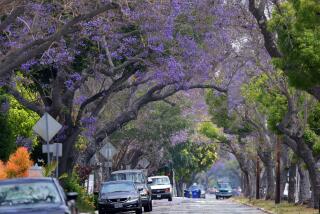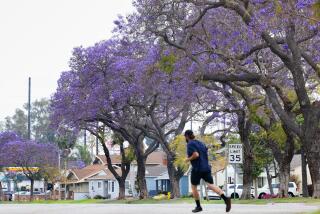Survival of the Fruitiest : Longer-Lasting Hybrid Strawberry Takes Over as King of the Patch From Sweeter-Tasting Variety
- Share via
VENTURA — The plump, glistening strawberries tumbling from cartons on Yoshiko Iwamoto’s Ventura fruit stand don’t look it, but they are part of a vanishing breed.
They are Chandler strawberries, a variety that has dominated Southern California berry production for more than a decade. But during the last three years, a new, hybrid strawberry has usurped the Chandler’s throne, replacing them in field after field.
The new berry grows faster and larger than the Chandler and lasts longer on the shelf. It is called a Camarosa, and strawberry farmers love it.
Unfortunately, some of their customers don’t.
“We’ve heard a lot of complaints that they’ve got no flavor,” Iwamoto said, describing Camarosas as shoppers crowded her Chandler-packed stall.
“We’ve got people coming up to us, asking if we’ve got Camarosas, because they don’t want them,” her husband, Kaz Iwamoto, said later. “I’ve heard people call them crunchy. I’ve heard one woman say it was like cardboard.”
The couple, partners in Oxnard’s Iwamoto and Gean Farm, are sticking with Chandlers and Seascapes, another variety. But then, their farm sells exclusively through farmers markets, where taste is more important than early maturity and shelf life means little.
“If I were a commercial berry grower,” Kaz Iwamoto said, “I’d definitely be growing Camarosas.”
Many Ventura County growers have switched. The new berry has been commercially available for just three years, but already it accounts for 56% of all strawberries grown in Ventura County, covering 2,873 acres.
Statewide, the Camarosa fills 6,100 acres, or 24% of the total $600-million crop, according to the California Strawberry Commission. That compares to 6% a year ago.
If growers have fallen for the Camarosa it is because the berry was designed to meet most of their needs. Like most strawberry varieties grown in the state, the Camarosa is the creation of University of California researchers constantly trying to improve the fruit.
More specifically, it is the labor of Victor Voth, who recently retired from the university after 50 years of working with strawberries. Voth and his colleagues at the university’s South Coast Research Extension in Irvine crossbreed the plants, taking as many as 10 years to perfect different varieties.
The researchers try to enhance traits that will boost growers’ profits. Size of the individual berries comes first, followed by total yield and firmness, which helps the fruit withstand shipping.
Taste comes somewhere after that.
“Sure, we breed for taste,” Voth said. “But if you don’t have those three [size, yield and firmness], taste isn’t going to help any. You have to get it to market.”
Voth named his creation Camarosa as a tip of the hat to Ventura County’s strawberry growers. The name is a combination of Camarillo and Santa Rosa and was inspired by the county’s Camarosa Irrigation District, Voth said. The quest for a firmer, bigger berry has led growers through a long line of varieties, many so far removed from the small, delicate wild strawberry that they might as well be a different plant.
Before the Chandler, most California strawberry farmers grew Douglas berries, considered very sweet but very soft. About 25 years ago, many farmers liked the taste of Sequoias, said grower Mike Conroy, but the fruit did not last long after picking.
“You couldn’t ship it as far as Albuquerque,” he said.
The Chandler reign has lasted longer than those of most varieties, which tend to fall out of favor after six to eight years, said David Riggs, the president of the strawberry commission.
Although sweet and fairly firm, Chandler plants start producing most of their berries slightly later than Douglas plants do. Growers now see the Camarosa, which starts producing steadily in late January or early February, as a way to combine the Douglas’ early yields and the Chandlers’ firmness, Riggs said.
Scott Deardorff is sufficiently impressed with tests of the new berry that, starting next year, his firm, Oxnard’s Deardorff-Jackson Co., will probably plant nothing but Camarosas. Unlike Iwamoto, Deardorff-Jackson ships most of his berries to markets in the Midwest, Texas and the Northeast.
With two or three days on the road between field and grocery store, Deardorff’s strawberries need a long shelf life. Chandlers do taste a bit better, Deardorff conceded, but more Camarosas will reach his distant customers intact. And those customers have noticed.
“Everyone wants the Camarosas because they arrive better, they last longer, and they come in nice and shiny and red,” Deardorff said.
Conroy, whose 200 acres east of Ventura contain nothing but Camarosas, said the new hybrid is also reliable, with consistently large, solid berries.
“You throw away less berries with the Camarosa than with the Chandler,” he said.
Conroy has heard people grouse that the new berry is not as sweet as the old, but the difference, he said, does not seem great enough to keep them from buying.
“They question the taste of the Camarosa, and there’s not much difference,” he said.
It is enough of a difference for some shoppers. At a recent farmers market in downtown Ventura, Stephanie Gregory picked up Chandlers, avoiding the Camarosas available at nearby stalls.
“I think they have a stronger, more tart flavor,” she said.
They also work better for cooking and baking than Camarosas, she said. “The pies look better,” she said. “The berries don’t dissipate.”
Brett and Kristie Ritter also chose Chandlers at the market. They tend to buy whichever berries taste best, the Ojai couple said, and although they have tasted good Camarosas, they often find the Chandlers more reliably sweet.
“Every now and then we’ll get a batch [of Camarosas], and they’ll look really good, but there’ll be a lot of ringers, bad ones, in there,” Brett Ritter said.
Voth, who also helped create the Chandler years ago, said there is nothing wrong with the Camarosa’s taste. Because the berries are a bit tougher than Chandlers, growers can and should leave them in the field longer than other strawberries, letting them ripen in the sun. That extra time will boost the berries’ flavor.
“The taste is fine,” he said. “The industry will have to learn to leave it on the vine a little longer. You don’t have to pick it so green.”
As for the Chandler berry, it seems doomed to a slow demise. Deardorff said the Camarosa has proven itself so well that soon, relatively few farmers will grow Chandlers.
“Some of the smaller guys who just do fruit stands may continue with them, because they do taste so good,” he said. But “I don’t think you’ll find many Chandlers next year.”
More to Read
Eat your way across L.A.
Get our weekly Tasting Notes newsletter for reviews, news and more.
You may occasionally receive promotional content from the Los Angeles Times.










